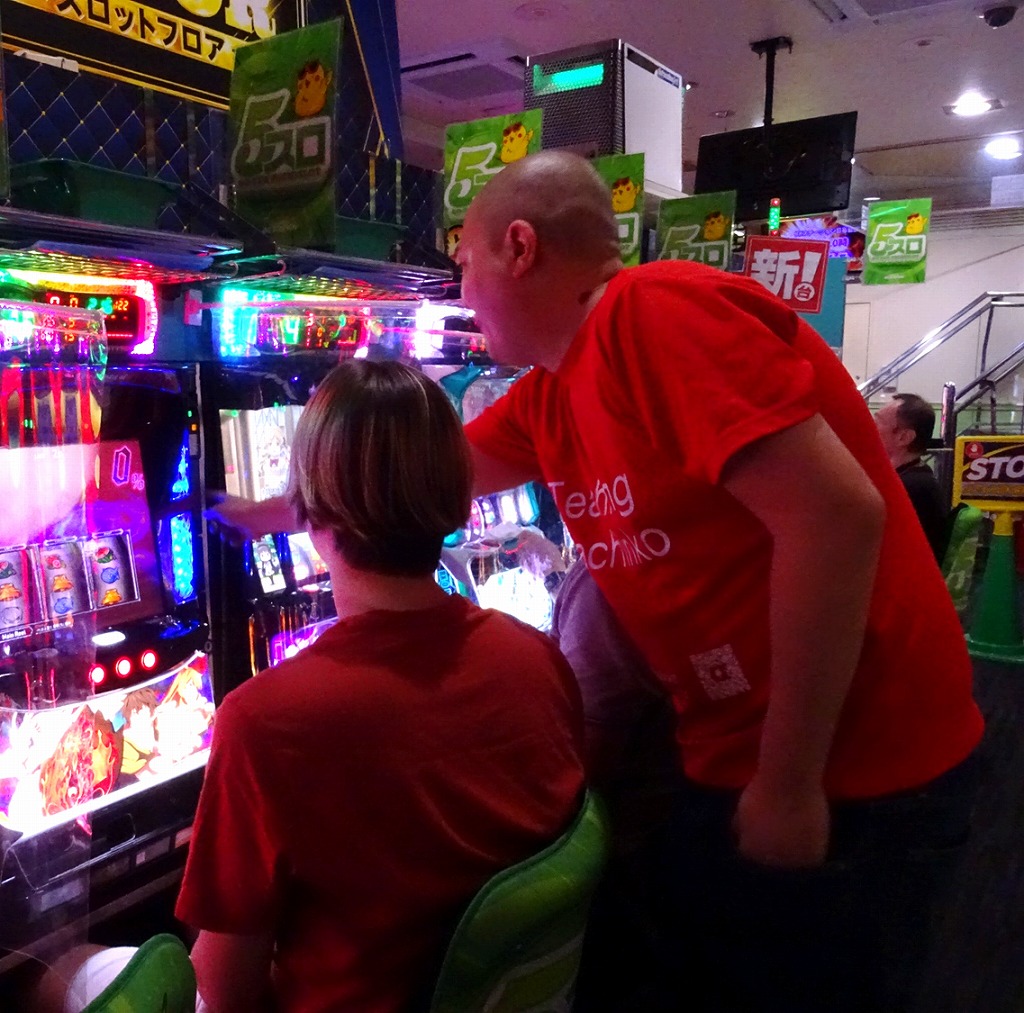新着記事
- パチセブントップ
- パチンコ&パチスロコンテンツ
- Pachinko the WORLD! 海外と外国人とジャパニーズパチンコ事情
- The Pachinko and Overseas & Foreigner Series: Analyse What is Needed for Pachinko and Pachislot Inbound Tourism?
Pachinko the WORLD! 海外と外国人とジャパニーズパチンコ事情

2024.02.08
The Pachinko and Overseas & Foreigner Series: Analyse What is Needed for Pachinko and Pachislot Inbound Tourism?
 長北 真
Pachinko the WORLD! 海外と外国人とジャパニーズパチンコ事情
長北 真
Pachinko the WORLD! 海外と外国人とジャパニーズパチンコ事情
Reflecting on whether the previous article was a bit short, and wondering why, out of four foreign contributors who had agreed to contribute, only one delivered their piece before the deadline, here we are at the seventh installment. The sound of an approaching topic drought is slowly becoming audible.
I amaze myself with how much I've managed to write on such a niche subject. Given that the previous piece focused on the "Actual Voices of Overseas Pachinko Fans," which was relatively aimed at a general audience, it seems okay to choose a topic this time that completely ignores the general user, right? So, including an explanation of what exactly I'm doing with a corporation set up for this very purpose, I plan to delve into the challenges and the necessary solutions for pachinko parlors to successfully welcome inbound tourists, achieving daily full houses and earning foreign currency in a two-part structure focusing on problem identification and proposing solutions.
Oddly enough, I was supposed to write this installment in the style of "A Diary of Playing Pachinko with a Foreigner."
Challenge 1: The Need for Extensive Translation
Not limited to pachislot but including pachinko as well, the gameplay is so extensive that it can't be fully explained in a simple pamphlet like "How to Play Pachinko." If we aim to fully acquaint people worldwide with the game at the same level as Japanese enthusiasts, it's clear that not only the basic instruction manuals or machine specifications available in parlors but also analytical websites for each machine model need translating.
Imagine being a beginner and finding all the written instructions in a pachinko parlor in Arabic. In a scenario where you're unsure of even the cost per medal or whether foreigners are allowed to play, deciding to put money into a machine would be quite the challenge.
هذا هو السبب في أن هذا هو السبب وراء ذلك. شكرا جزيلا
هذا هو السبب في أن هذا هو ما يحدث في المستقبل
هذا هو السبب في أن هذا هو السبب وراء ذلك. حسنًا ، هذا
▲(For Japanese) Do you play pachinko if the writing in the place is like that.
The cost of translation varies significantly by language, with general translations costing about 10 to 20 yen per character, and specialized translations possibly costing 30 to 50 yen per character—bearing in mind that content related to Pachinko also falls under specialized translation.
For languages like Chinese and Korean, which tend to have fewer characters, the rates might be higher, but generally, the cost across languages does not differ significantly. It's worth noting that the typical translation speed for a professional freelance translator is about 3,000 to 4,000 characters per day. For example, just counting the characters on the "Pachislot Kabaneri of the Iron Fortress" page, there are about 20,000 characters. To translate everything for all current machine models would be an impossible game, to say the least.
Challenge 2: Securing and Training Talent
Simply translating texts into foreign languages isn't enough to attract people. If foreigners are to visit pachinko parlors, it naturally becomes necessary to have staff with a reasonable level of foreign language conversational skills, and acquiring such multilingual talent, as well as managing them, incurs significant costs.
Hiring young individuals (not necessarily young, though) who are proficient in both Japanese and a foreign language costs about five times more than hiring monolingual individuals. This cost isn't just monetary but also includes various efforts in terms of time and company branding, considering that bilingual Japanese make up only about 2 to 20% of the population.
(Note: There are various definitions of bilingualism, but one definition states that if a person can guide someone asking for directions in another language, they are considered bilingual. By this definition, about 20% of Japanese are bilingual. If we define bilingualism as being fluent enough in another language to use it problem-free in business, this number drops to around 2.5%.)
Considering this, the challenge becomes even more complex: what percentage of these bilingual individuals are willing to work in the pachinko industry? Even gathering skilled personnel is difficult, and bilingual individuals could be considered almost like national treasures. Moreover, with the yen's depreciation, working overseas as "someone who can speak Japanese" might offer better conditions, making bilinguals in Japan somewhat rare.
Furthermore, managing and training such individuals would require someone akin to a manager. It's not just about English skills; since many bilinguals possess a certain level of education and career experience, managing them necessitates a manager with even higher qualifications.
To illustrate with an extreme example: can a manager, loyal to the industry for 20 years with only a high school diploma, effectively manage someone who graduated from Boston University and has transitioned through three jobs in multinational corporations? It's not impossible, but you can expect situations where the latter might unintentionally "outclass" their superior in terms of management training backgrounds. That's almost a given.
When hiring someone for their foreign language skills, skill verification becomes necessary. Of course, this means that the interviews must be conducted by someone who possesses those language skills.
Challenge 3: The Hurdle of Sharing the Fun
This seems simple to articulate, but personally, I consider it the most significant barrier. While issues like translation and human resources can ultimately be solved with money, does that apply here as well? For instance, with "translation" or "human resources," you can throw money at the problem to find a solution. If a translation is needed, how much you're willing to pay and which company you entrust become the only concerns. For "human resources," offering a salary of say, 30 million yen, will likely bring in capable individuals. As for training, leaving it to those capable individuals usually works out. "If it pays off, someone will be willing to invest."
However, conveying "fun" is not that simple.
"Conveying fun"…? It might sound somewhat understandable, but let me break it down a bit.
The "how to play pachinko and pachislot" knowledge is somewhat widespread already. Various information sites provide basic knowledge, and the industry also does its part in dissemination. Some might have even encountered it in "Yakuza" series or "Cyberpunk 2077."
The question then becomes, after watching such videos, does one get excited and think, "Wow, pachinko is amazing! I must play it when I visit Japan!"?
These are "explanatory videos," and the reaction they elicit is usually, "Thanks for the explanation," nothing more. This is not exclusive to foreigners; informative content from someone with knowledge about the enjoyable aspects might spark interest in trying it out. To be clear, it's not that such content is unnecessary or wasteful. It's essential but insufficient on its own.
Many readers, being somewhat experienced pachinko or pachislot players, might remember their first day at a parlor. Often, it starts with being introduced to it by a mischievous senior, parent, or boyfriend, getting bombarded with cryptic terms like "Look, a fish school!" or "That's a Gachena, right?!", and experiencing a bewildering series of jackpots. From there, one gradually learns about jackpot probabilities and chain reaction rates until one day, you're declaring, "Seeing Gachena today means I've essentially won," or "Waiting for the lever pull feels calming, like fishing."
Given the mechanics where hundreds of thousands can be won or lost in half a day, it's impossible to offer the kind of casino dream where one might say, "I hit the jackpot at a casino in Japan and won 45 million yen!" Instead, whether they are foreigners or locals, they need to become the kind of enthusiasts who can say, "I put in 70,000 yen, but seeing Rei vs. Asuka on the actual machine means I've essentially won."
To achieve this requires a certain level of preparation. To put it plainly, "Even those who don't know a lick of Japanese need to learn what makes pachinko thrilling." This was the most significant missing piece. In reality, tackling this alone is too vast a challenge, meaning that every pachinko and pachislot-related YouTuber in Japan would need to suddenly become fluent in foreign languages and start mass-producing videos for this to work.
Challenge 4: Who Will Solve These Issues?
This leads to the subsequent question: Who will consolidate and address these challenges? Let's start by identifying the key players: manufacturers, parlors, associations, users, and others (like our company or various information websites). Naturally, each has its capabilities, but this brings us to the problem of who takes the lead.
In essence, having just one party say, "We want to attract foreigners to pachinko parlors!" isn't going to cut it. To illustrate:
Example 1:
If a manufacturer suddenly announces, "We've created a machine that's fully English compatible!!" but the customers aren't aware, it ends up being a waste.
Example 2:
An external media (such as Pachi7) creates gameplay explanations in foreign languages, but it doesn't lead to increased traffic. If there's no widespread knowledge of pachinko itself, and users aren't searching for "〇〇 (machine name) analysis" or recognizing the need for such information, the invested cost is lost.
Example 3:
A parlor prepares for foreign patronage, but fails to advance its information dissemination. Even if a parlor, let's say 〇〇, supports multiple languages, trying to broadcast that on a store level has its limits. Also, attempting to convey the "fun" on a store basis will likely be just as constrained.
To put it simply, this is the situation. Despite the pachinko industry's notorious lack of coordination, it's essential for all involved parties to share a common understanding and synchronize their efforts to move forward effectively.
Simply creating a pamphlet on "How to Play Pachinko" and outsourcing the translation, then posting articles on travel sites, isn't sufficient. This misunderstanding has led to past failures. Although it's too extensive to detail every point, I've outlined five major challenges:
1.Translation
2.Talent Acquisition and Development
3.Sharing the Fun
4.Who Will Solve These Issues?
5.Legal and Police Matters
I've covered these challenges here, but there's much more to say. Rather than dragging on and potentially dampening spirits with lengthy explanations, I plan to discuss solutions in a separate piece. Next time, I'll explore the topic "AI, Foreigners, and Pachinko." Wondering where AI fits into this or if there are indeed solutions to these challenges? You might as well bookmark this and stay tuned for the next installment.
See you next time!
We are seeking participants to experience pachinko through our pachinko tours!

We have organized a special tour to introduce pachinko, a traditional Japanese form of entertainment, to our foreign friends. On this tour, you will be accompanied by an instructor who is fluent in English and well-versed in pachinko, providing detailed guidance from the basics to advanced techniques. Pachinko, known for its bright lights and unique sounds, has been a beloved game in Japan for over 80 years. Although the tour is just two hours, it offers a wealth of knowledge about pachinko's history and how to play!
0
6
共有する

- 長北 真
- 代表作:Pachinko the WORLD! 海外と外国人とジャパニーズパチンコ事情
観光×パチンコをテーマに、パチンコツアーの展開。パチンコ店舗の外国人受け入れ支援(スタッフ教育、店内ルール説明文、英語アナウンス制作等)、海外に向けた情報発信や海外パチンコファンコミュニティの運営等をおこなっております。






